Australia’s natural wonder is on the frontline of climate change, and urgent action is needed to prevent irreversible loss.
The Great Barrier Reef, one of the world’s most recognizable natural wonders, stretches over 2,300 kilometers along Australia’s northeast coast. It’s a vibrant mosaic of marine life, supporting around 1,500 species of fish, 411 types of hard coral, and countless other creatures, from tiny seahorses to majestic sea turtles. But the reef, a UNESCO World Heritage site, is in grave danger.
The Crisis of Coral Bleaching
At the heart of this unfolding tragedy is coral bleaching, a stress response caused primarily by rising sea temperatures. When ocean waters warm, corals expel the symbiotic algae (zooxanthellae) living in their tissues, which provide them with both color and crucial nutrients through photosynthesis. Without these algae, the corals turn ghostly white and struggle to survive.
The Great Barrier Reef has experienced seven mass bleaching events since 1998, with particularly devastating episodes in 2016, 2017, 2020, 2022, 2024, and 2025. Scientists now warn that the frequency and intensity of these events are likely to increase as global temperatures continue to rise, fueled by human-induced climate change. Recent reports indicate that coral bleaching on the Great Barrier Reef has reached ‘catastrophic’ levels, with significant coral mortality observed in various regions. Reference: The University of Sydney
The Human Footprint
While warming waters are the primary driver, the reef faces a perfect storm of additional stressors, including:
Pollution and Runoff: Agricultural runoff carrying sediments, pesticides, and fertilizers chokes coral and fuels destructive algae blooms.
Coastal Development: The expansion of ports and dredging disrupts habitats and clouds the water, blocking vital sunlight.Great Barrier Reef Foundation
Overfishing: Disrupts the delicate balance of reef ecosystems, making them more vulnerable to disease and environmental change.
Government Responses
Australia has committed billions of dollars to reef protection, including the $4.4 billion “Reef 2050 Long-Term Sustainability Plan,” which aims to reduce agricultural runoff, improve water quality, and restore damaged habitats. In 2022, the federal government pledged an additional $1.2 billion to strengthen reef resilience, fund scientific research, and boost conservation efforts.
The government also recently proposed tightening emissions targets, a critical step given that climate change is the most significant threat to the reef’s survival. Yet critics argue that these efforts are undermined by Australia’s continued investment in coal and gas projects, which directly contribute to the very warming that threatens the reef.
Voices from the Frontline: The Australian Marine Conservation Society
The Australian Marine Conservation Society (AMCS) has been vocal in its criticism of current efforts to protect the reef. Following the latest mass bleaching event, AMCS Great Barrier Reef Campaigner Simon Miller stated:
“After the devastation of 2024, this summer delivered another major hit with back-to-back mass bleaching events for only the second time on record. These reports continue to show the damage climate change is causing, but they must lead to action. Monitoring is essential, but it cannot be where our response ends. Australia must rapidly slash climate pollution and stop new fossil fuel approvals.”
AMCS is calling for the Australian and Queensland governments to adopt reef-safe climate policies, including cutting climate pollution by 90% by 2035, ending approvals for new coal and gas projects, and establishing a Reef emergency response plan to protect coral ecosystems under increasing pressure from warming oceans, floods, and pollution.
Preserving a Natural Wonder for Future Generations
Protecting the Great Barrier Reef isn’t just about saving a stunning seascape. It’s about preserving a crucial part of our planet’s biodiversity, safeguarding the livelihoods of tens of thousands of people, and ensuring future generations inherit a world as rich and vibrant as the one we know today.
For the Great Barrier Reef to survive, Australia and the world must act swiftly and decisively. This means accelerating the transition to renewable energy, enforcing stricter pollution controls, and investing in innovative coral restoration techniques like selective breeding for heat-resistant coral strains.
Ultimately, the fight to save the Great Barrier Reef is a test of humanity’s ability to preserve the natural wonders that have defined our planet for millennia. As the world watches, the stakes have never been higher.


